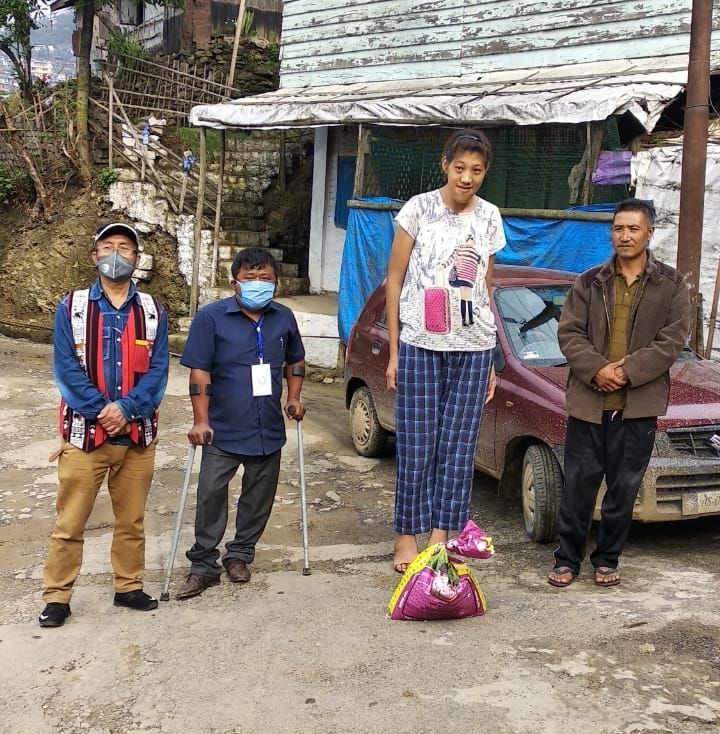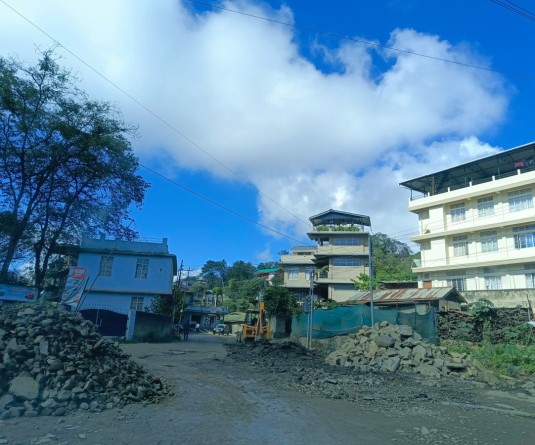Thsarubla with CSS and MDDF members during the COVID-19 relief distribution on April 23, 2020. (Photo Courtesy: CSS)

Morung Express News
Dimapur | September 13
At 7 feet, 20-year old Thsarubla from Salangtem Ward in Mokokchung could possibly be one of the tallest women in the State.
While she attracts a lot of attention because of her towering height, there is more to her story than what meets the eye.
Born on October 5, 1999, Thsarubla reportedly suffers from a condition called Acromegaly or gigantism.
Persons with Acromegaly witness the production of excessive growth hormones in their body.
According to doctors, overproduction of growth hormone is almost always caused by a non-cancerous (benign) pituitary tumor. Thsarubla’s parents Chokhase and Rebecca did not know of their daughter’s health condition until she was in high school.
The long hours in school would tire her out and Thsarubla would be too weak by the end of the day. She would be bed ridden for a week after attending the classes. Added to that, she suffered from frequent episodes of fainting and severe headaches. She has also developed hearing problems.
Eventually, by the time she reached eighth standard, Thsarubla had to drop out of school owing to her health condition.
A Magnetic Resonance Image (MRI) scan in 2009 revealed a tumor in the pituitary gland of her brain.
While she was referred to Guwahati for treatment, Thsarubla’s family was unable to afford the expenses and could not pursue her treatment.
Her father is a daily wage earner while her mother is a homemaker.
The Care and Support Society (CSS), an NGO working with the differently-abled in Mokokchung came across Thsarubla and her family in 2016 and has been extending whatever help they can to Thsarubla and her family.
According to Imchawati Kichu, Director and Chief Functionary of CSS, the Society helped her get certified for Person with Disabilities (PwD). Besides that, Thsarubla is also encouraged to attend various programmes to help her socialize and accept her condition.
The relief items provided to the family as part of the COVID-19 relief for the differently-abled in the district was the most recent help they could extend, according to Imchawati.
While the CSS has also been trying to apply for a disability pension for Thsarubla, the same has not been possible till date.
“The State government’s intervention could help her and those with similar conditions,” Imchawati opined.
Thsarubla was reported to be 6 feet 10 inches in 2018 when her story was picked up by a local daily in Nagaland. Two years later, she is still living with the condition, with little or no help in sight.
But finding clothes that fit, shoes her size and avoiding curious glances from people is the least of Thsarubla’s problems.
According to a medical practitioner in Dimapur, the treatment requires a specialized neurosurgical intervention. With the State lacking a neurosurgeon, the nearest possible aid for Thsarubla would be in Guwahati, Assam.
But the treatment is extensive and expensive. A surgery of the tumor followed by radiotherapy and subsequent treatment would require a huge amount of money.
These days, Thsarubla spends time at home, helping with the household chores as much as she can. “She cannot do heavy work, as it tires her out,” her mother shared.
Though the episodes of fainting have stopped, she still struggles with loss of appetite, fatigue and painful joints.
With timely treatment, a person with Acromegaly can pursue a normal and healthy life.
But for now, Thsarubla can only hope for an intervention.





